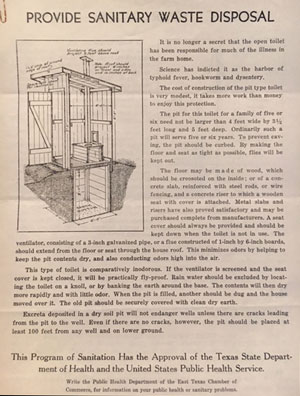
When my husband comes home with an old newspaper article, or a real treasure from the past, or even directions for “Rural Sanitation”, I know some of his acquaintances are doing some deep cleaning, probably getting ready to downsize their life style. They are well-aware of my love for historical stuff.
This week’s treasure was a four-page leaflet called “Rural Sanitation.” It is in very good condition. I suspect since it was issued by the Public Health Department of East Texas Chamber of Commerce that it was released during the New Deal of Franklin D. Roosevelt’s tenure as U. S. president. That was a time of strong Progressive Movements.
While Progressives were very active between 1900 and World War I, I believe this particular piece is not that old. During the New Deal of the Great Depression, emphasis was placed on rural residents as much as city dwellers. Besides, most small towns like Greenville had a modern city sewer system at that time.
So, what is inside this gem? A brief examination of what rural homes need: protection. Protection against deadly diseases that were caused by filth and unsanitary conditions. The leaflet examined mosquito proofing homes, safe well and cistern water sources, and a sanitary pit type toilet for human waste disposal.
Malaria is caused by a parasite which lives in the blood stream of its victims, and in the growth and multiplication destroys red blood cells which cause attacks of chills and fever. The parasite is carried from person to person by the Anopheles mosquito. To control malaria meant control of the Anopheles mosquito. The leaflet strongly suggests screen doors and windows and other openings. The Public Health Department of the East Texas Chamber of Commerce delivered screen doors to homes for $2.50 and windows for .40 cents each.
A Water System that will provide a wholesome supply for family use, prove serviceable for farm purposes, and cost as little as possible is one of the principal utility problems for the average farmer. A well-conceived plan could not be over-estimated. Haphazard methods and make shift devices result in waste, dissatisfaction, danger, and abandonment.
A well dug in Virginia caused intestinal problems when frogs were discovered in it. Typhoid fever was a constant fear here in Texas. Three out of four farm water supplies were sufficiently polluted to be unsafe. The Texas Department of Health and the Public Health Department of the East Texas Chamber of Commerce aided farmers to have water analyzed.
A detailed description of constructing a pit type toilet was provided, saying it took more work than money to enjoy this protection. Leaflets were available at many locations. Evidently this was a task the farmer and his family could do themselves. The pit would typically last five or six years.
For a good idea of rural life during the New Deal and earlier, take a trip to the Audie Murphy/American Cotton Museum east of Greenville on Interstate 30. There is a life-sized exhibit of a woman sitting in her home with newspapers covering the walls to keep out cold wind and sand. A very typical screen door is to one side. For those of us who never experienced this life-style it is a must see! And no, this was not a life style of mine. I have always lived in town, even though I visited relatives on their farms and ranches.
